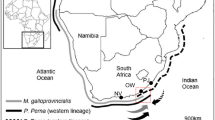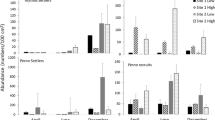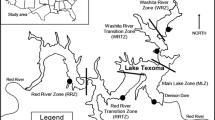Abstract
Age structure, recruitment, and survivorship of a Jamaica Bay, New York ribbed mussel (Geukensia demissa) population were studied over nine years at two shore elevations. Mussels were collected in November (following seasonal growth and recruitment) and March (to assay over-winter mortality). Larval recruits (0-class) averaged 55% of the population at the marsh edge compared with <9% at the higher elevation (6 m upshore). High larval settlement at the edge apparently depletes the larval supply available for settlement within the marsh interior. At the edge, the population generally contained 7 monotonically decreasing age classes compared to 15–20 age classes at the interior site. At the interior site, most 0-class mussels may not directly settle into existing mussel aggregations, but instead immigrate over a period of two years following settlement. The linear survivorship curve at the edge reflects 40–50% mortality every year. Over-winter mortality is sensitive to winter ice conditions. Simulations of reproductive output based on survivorship and fertility data combined suggest that mussel cohorts living in the marsh may approach the life time reproductive output of marsh edge mussels after about 15 years, a life span which is not uncommon at higher shore levels.
Similar content being viewed by others
Literature Cited
Bertness, M. D. 1980. Growth and mortality of the ribbed musselGeukensia demissa (Bivalvia: Dreissenacea).The Veliger 23: 62–69.
Bertness, M. D. 1984. Ribbed mussels andSpartina alterniflora production in a New England salt marsh.Ecology 65:1794–1807.
Bertness, M. D. andE. Grosholz. 1985. Population dynamics of the ribbed mussel,Geukensia demissa: The costs and benefits of an aggregated distribution.Oecologia 67:192–204.
Brousseau, D. 1984. Age and growth rate determination for the Atlantic ribbed musselGeukensia demissa Dillwyn (Bivalvia: Mytilidae).Estuaries 7:233–241.
Castagna, M. andP. Chanley. 1973. Salinity tolerance of some marine bivalves from inshore and estuarine environments in Virginia waters of the western Mid-Atlantic coast.Malacologia 12:47–96.
Franz, D. R. 1993. Allometry of shell and body weight in relation to shore level in the intertidal bivalveGeukensia demissa (Bivalvia: Mytilidae).Journal of Experimental Marine, Biology and Ecology 174:193–207.
Franz, D. R. 1996. Size and age at first reproduction of the ribbed musselGeukensia demissa (Dillwyn) in relation to shore level in a New York salt marsh.Journal of Experimental Marine Biology and Ecology 205:1–13.
Franz, D. R. 1997. Resource allocation in the intertidal saltmarsh musselGeukensia demissa in relation to shore level.Estuaries 20:134–148.
Franz, D. R. andJ. T. Tanacredi. 1993. Variability in growth and age structure among populations of ribbed musselsGeukensia demissa (Dillwyn) (Bivalvia: Mytilidae), in Jamaica Bay, New York (Gateway NRA).The Veliger 36:220–227.
Griffiths, R. J. 1981. Population dynamics and growth of the bivalveChoromytilus meridionalis (Kr.) at different tidal levels.Estuarine, Coastal and Shelf Science 12:101–118.
Griffiths, C. L. andR. J. Griffiths. 1987. Bivalvia, p. 1–88.In J. J. Pandian and F. John Vernberg (eds.), Animal Energetics, Volume 2. Academic Press, Inc., New York.
Jordan, T. E. andI. Valiela. 1982. A nitrogen budget of the ribbed mussel,Geukensia demissa, and its significance in nitrogen flow in a New England salt marsh.Limnology and Oceanography 27:75–90.
Kreeger, D. A., C. J. Langdon, andR. I. E. Newell. 1988. Utilization of refractory cellulosic carbon derived fromSpartina alterniflora by the ribbed musselGeukensia demissa.Marine Ecology Progress Series 42:171–179.
Kuenzler, E. J. 1961. Structure and energy flow of a mussel population in a Georgia salt marsh.Limnology and Oceanography 6:191–204.
Lent, C. M. 1968. Air-gaping by the ribbed mussel,Modiolus demissus (Dillwyn): Effects and adaptive significance.Biological Bulletin 134:60–73.
Lutz, R. A. andM. Castagna. 1980. Age composition and growth rate of a mussel (Geukensia demissa) population in a Virginia salt marsh.Journal of Molluscan Studies 64:106–115.
McDonald, P. D. M. 1987. Analysis of length-frequency distributions, p. 371–384.In R. C. Summerfelt and G. E. Hall (eds.), Age and Growth of Fish. Iowa State University Press, Iowa.
National Academy of Sciences. 1971. Jamaica Bay and Kennedy Airport: A multi-disciplinary environmental study, Volume II. National Academy of Sciences, Washington, D.C.
Nielsen, K. J. andD. R. Franz. 1995. the influence of adult conspecifics and shore level on recruitment of the ribbed musselGeukensia demissa (Dillwyn).Journal of Experimental Marine Biology and Ecology 188:89–98.
Peterson, B. J., R. W. Howarth, andR. H. Garritt. 1985. Multiple stable isotopes used to trace the flow of organic matter in estuarine food webs.Science 227:1361–1363.
Seed, R. 1980. Predator-prey relationships between the mud crabPanopeus herbstii, the Blue CrabCallinecles sapidus and the Atlantic Ribbed MusselGeukensia (=Modiolus) demissa.Estuarine, Coastal and Shelf Science 11:445–458.
Stiven, A. E. andS. A. Gardner. 1992. Population processes in the ribbed mussel,Geukensia demissa (Dillwyn), in a North Carolina salt marsh tidal gradient: Spatial pattern, predation, growth and mortality.Journal of Experimental Marine Biology and Ecology 160:81–102.
West, D. L. andA. H. Williams. 1986. Predation byCallinectes sapidus (Rathbun) withinSpartina alterniflora (Loisel) marshes.Journal of Experimental Marine Biology and Ecology 100:75–95.
Author information
Authors and Affiliations
Rights and permissions
About this article
Cite this article
Franz, D.R. Recruitment, survivorship, and age structure of a New York ribbed mussel population (Geukensia demissa) in relation to shore level—a nine year study. Estuaries 24, 319–327 (2001). https://doi.org/10.2307/1353234
Received:
Accepted:
Issue Date:
DOI: https://doi.org/10.2307/1353234




